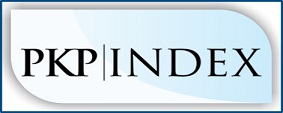Analisis Kemampuan Literasi Matematis Siswa SMA Kelas X Dalam Menyelesaikan Soal Tipe Pisa Konten Change and Relationship
Abstract
Penelitian ini bertujuan untuk mendeskripsikan capaian kemampuan literasi matematis siswa dalam menyelesaikan soal tipe PISA konten change and relationship. Jenis penelitian yang digunakan adalah penelitian deskriptif dengan pendekatan kualitatif. Pengumpulan data dilakukan dengan tes kemampuan literasi matematis dan wawancara. Subjek penelitian adalah peserta didik kelas X SMAN Mojoagung Tahun Pelajaran 2021/2022 yang masing-masing satu orang berkemampuan tinggi, sedang dan rendah. Data yang didapatkan kemudian direduksi dan dianalisis secara kualitatif dengan memperhatikan indikator-indikator kemampuan proses matematis siswa. Hasil penelitian ini menunjukkan bahwa siswa berkemampuan tinggi mampu menunjukkan kemampuan literasi matematis yang baik, yakni siswa mampu memenuhi ketiga aspek proses matematis yakni formulate, employ dan interprete dengan baik. Siswa berkemampuan sedang hanya mampu memenuhi dua indikator pada aspek proses matematis yakni formulate dan employ. Siswa berkemampuan rendah tidak dapat memenuhi seluruh indikator pada aspek proses matematis, siswa berkemampuan rendah hanya memenuhi satu aspek proses matematis yakni formulate. Bagi peneliti selanjutnya, agar meneliti faktor-faktor yang mempengaruhi rendahnya kemampuan literasi matematis pada jenjang SMA/sederajat.
Downloads
References
Baiduri. (2019). Strategi Literasi Dalam Pembelajaran Matematika Pada Era Industri 4.0. Journal of Mathematics Education, Science and Technology, 4(1), 77-94. http://dx.doi.org/10.30651/must.v4i1.2782
Dewantara, A.H., Zulkardi, & Darmawijoyo. (2015). Assesing Seventh Graders’ Mathematical Literacy in Solving PISA-Like Task. Journal on Mathematics Education,6(2), 39-49. https://doi.org/10.22342/jme.6.2.2163.117-128
Edo, S. I., Hartono, Y., & Putri, R. I. I. (2013). Investigating secondary school students’ difficulties in modeling problems PISA-model level 5 and 6. Journal on Mathematics Education, 4(1), 41–58. https://doi.org/10.22342/jme.4.1.561.41-58
Ehmke, T., Ham, A-K., Sälzer, C., Heine, J., & Prenzel, M. (2020). Measuring mathematics competence in international and national large scale assessments: Linking PISA and the National Educational Panel Study in Germany. Studies in Educational Evaluation, 65, (100847). https://doi.org/10.1016/j.stueduc.2020.100847
Fadillah, A., & Ni’mah. (2019). Analisis Literasi Matematika Siswa dalam Memecahkan Soal Matematika PISA Konten Change and Relationship. Jurnal Teori Dan Aplikasi Matematika, 3(2), 127–131. https://doi.org/10.31764/jtam.v3i2.1035
Genc, M., & Erbas, A. K. (2019). Secondary Mathematics Teachers ’ Conceptions of Mathematical Literacy. International Journal of Education in Mathematics, Science and Technology (IJEMST), 7(3), 222-237.
Gomes, M., Hirata, G., & Oliveira, J.B.A. (2020). Student composition in the PISA assessments: Evidence from Brazil. International Journal of Educational Development, 79. https://doi.org/10.1016/j.ijedudev.2020.102299
Gravemeijer, K., Stephan, M., Julie, C., Lin, F., Ohtani, M. (2017). What mathematics education may prepare students for the society of the future?. International Journal of Science and Mathematics Education, 15(1), 105-123. https://doi.org/10.1007/s10763-017-9814-6
Haara, F.O., Bolstad, O.H., & Jenssen, E.S. 2017. Research on mathematical literacy in schools Aim, approach and attention. European Journal of Science and Mathematics Education, 5(3): 285−313. https://doi.org/10.30935/scimath/9512
Hesse, F., Care, E., Buder, J., Sassenberg, K., & Griffin, P. (2015). A framework for teachable collaborative problem-solving skills. In Assessment and teaching of 21st century skills (pp. 37-56). Dordrecht: Springer. https://doi.org/10.1007/978-94-017-9395-7_2
Hwang, J. & Ham, Y. (2021). Relationship Between Mathematical Literacy and Opportunity to Learn With Different Types of Mathematical Tasks. Journal on Mathematics Education, 12(2), 199-222. https://doi.org/10.22342/jme.12.2.13625.199-222
Jannah, R. D., Putri, R. I. I., & Zulkardi. (2019). Soft Tennis and Volleyball Contexts in Asian Games For PISA-Like Mathematics Problems. Journal on Mathematics Education, 10(1), 157-170. https://doi.org/10.22342/jme.10.1.5248.157-170
Johar, R. (2012). Domain soal PISA untuk literasi matematika. Jurnal Peluang, 1(1), 30–41.
Julie, H., Sanjaya, F., & Anggoro. A.Y. (2017). The Students’ Ability in Mathematical Literacy for The Quantity, and The Change and Relationship Problems on The PISA Adaptation Test. Journal of Physics: Conf. Series 890 (2017) 012089.
Malasari, P. N., Herman, T., & Jupri, A. (2017). The Construction of Matehmatical Literacy Problems for Geometri. Journal of Physics: Conf. Series 895 (2017) 012071, 1-7. http://dx.doi.org/10.1088/1742-6596/895/1/012071
Moleong, L. J. (2016). Metodologi Penelitian Kualitatif Edisi Revisi. Bandung: PT.Remaja Rosdakarya.
Nizar, Harisman, Putri, R. I. I. dan Zulkardi (2018) “Developing pisa-like mathematics problem using the 2018 Asian Games football and table tennis context,” Journal on Mathematics Education, 9(2), 183–194. doi: 10.22342/jme.9.2.5246.183-194.
Novita, R., Zulkardi, & Hartono, Y. (2012). Exploring Primary Student’s Problem Solving Ability by Doing Tasks Like PISA’s Question. IndoMS. J.M.E, 3(2), 133–150. https://doi.org/10.22342/jme.3.2.571.133-150
Nugrahanto, S., & Zuchdi, D. (2019). Indonesia PISA Result and Impact on The Reading Learning Program in Indonesia. In International Conference on Interdisciplinary Language, Literature and Education (ICILLE 2018). Atlantis Press. http://dx.doi.org/10.2991/icille-18.2019.77
Nusantara, D. S., Zulkardi, & Putri, R. I. I. (2020a). Designing PISA-like mathematics problem in COVID-19 pandemic (PISAComat). Journal of Physics Conference Series, 1657(1), 012057. https://doi.org/10.1088/1742-6596/1657/1/012057
Nusantara, D. S., Zulkardi, & Putri, R. I. I. (2020b). Designing PISA-like mathematics problem relating change and relationship using physical distancing context. Journal of Physics Conference Series, 1663(1), 012004. https://doi.org/10.1088/1742-6596/1663/1/012004
Nusantara, D. S., Zulkardi, & Putri, R. I. I. (2021). Designing Pisa-Like Mathematics Task Using A Covid-19 Context (Pisacomat). Journal on Mathematics Education, 12 (2), 349–364. https://doi.org/10.22342/jme.12.2.13181.349-364
OECD. (2013). PISA 2012 Assessment and Analytical Framework: Mathematics, Reading, Science, Problem Solving and Financial Literacy. Paris: OECD Publishing.
OECD. (2019). PISA 2018: Insights and interpretations. Paris: OECD Publishing.
Permatasari, R., Putri, R.I.I., & Zulkardi. (2018). PISA-like: Football context in Asian Games. Journal on Mathematics Education, 9(2), 271-280. https://doi.org/10.22342/jme.9.2.5251.271-280
Putri, R. I. I. & Zulkardi. (2018). Higher-order thinking skill problem on data representation in primary school: A case study. Journal of Physics Conference Series, 948(1), 012056. https://doi.org/10.1088/1742-6596/948/1/012056
Rizki, L.M., & Priatna, N. (2019). Mathematical Literacy as The 21st Century Skill. Journal of Physics: Conference Series 1157 (2019) 042088. http://dx.doi.org/10.1088/1742-6596/1157/4/042088
Sari, R. H. N. (2015). Literasi Matematika : Apa , Mengapa dan Bagaimana ? Seminar Nasional Matematika Dan Pendidikan Matematika, 713–720.
Seidel, T., & Prenzel, M. (2008). Large scale assessment. In J. Hartig, E. Klieme, & D.
Leutner (Eds.). Assessment of competencies in educational contexts. State of the art and future prospects (pp. 279–304). Göttingen: Hogrefe & Huber.
Van Laar, E., van Deursen, A.J.A.M., van Dijk, J.A.G.M., & de Haan, J. (2020). Determinants of 21st-Century Skills and 21st-Century Digital Skills for Workers: A Systematic Literature Review. SAGE Open, 10 (1). https://doi.org/10.1177/2158244019900176
Wijaya, A., Van den Heuvel-Panhuizen, M., Doorman, M., & Robitzsch, A. (2014). Difficulties in solving context-based PISA mathematics tasks: An analysis of students’ error. The Mathematics Enthusiast, 11(3), 555-584.
Wijaya, A., Van den Heuvel-Panhuizen, M., Doorman, M. (2015). Opportunity to learn context-based tasks provided by mathematics textbooks. Educational Studies in Mathematics, 89, 41-65. https://doi.org/10.1007/s10649-015-9595-1
Yalcin, M., Aslan, S., & Usta, E. 2012. Analysis of PISA 2009 Exam According to Some Variables. Mevlana International Journal of Education (MIJE), 2 (1): 64-71.
Yılmazer, G., & Masal, M. (2014). The Relationship between Secondary School Students’ Arithmetic Performance and their Mathematical Literacy. Procedia Social and Behavioral Sciences, 152, (619-623).
Copyright (c) 2021 Rohmah Nila Farida, Abd Qohar, Swasono Rahardjo

This work is licensed under a Creative Commons Attribution-ShareAlike 4.0 International License.



1.jpg)














